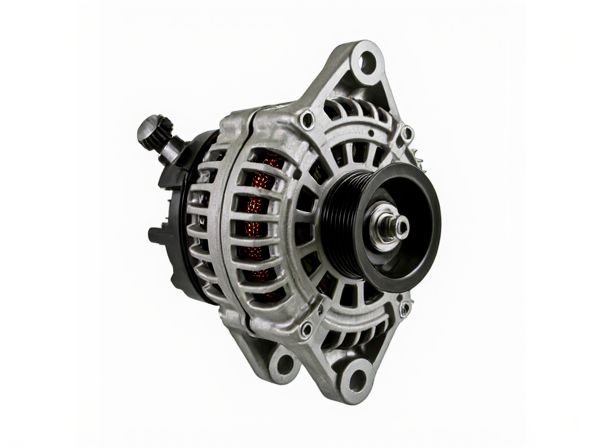
Photo illustration: Slip Ring vs Tapered Shaft Connection
A slip ring connection provides electrical continuity between stationary and rotating parts, ideal for transmitting power and signals without restricting movement. Tapered shaft connections create a secure mechanical fit using a conical interface, ensuring precise alignment and torque transmission under heavy loads. Your choice depends on whether you prioritize continuous electrical contact or robust mechanical coupling for rotational components.
Table of Comparison
| Feature | Slip Ring Connection | Tapered Shaft Connection |
|---|---|---|
| Function | Transfers electrical power using rotating slip rings | Provides mechanical connection via tapered shaft fit |
| Application | Common in alternators for continuous electrical contact | Used for secure mechanical coupling in alternator drives |
| Durability | Prone to wear due to brush and ring contact | High mechanical strength and longevity |
| Maintenance | Requires regular inspection of brushes and rings | Minimal maintenance after proper installation |
| Installation Complexity | Relatively simple electrical assembly | Precise mechanical fitting needed for optimal performance |
| Cost | Moderate cost due to electrical components | Typically higher due to precision machining |
Introduction to Slip Ring and Tapered Shaft Connection
Slip rings enable the transfer of electrical signals and power between stationary and rotating components, commonly used in rotating machinery and wind turbines to maintain continuous electrical connection without cable twisting. Tapered shaft connections provide secure mechanical joining by fitting a conical shaft into a matching tapered bore, ensuring high torque transmission with self-locking properties commonly applied in gearboxes, pulleys, and couplings. Both technologies optimize rotational interface efficiency, slip rings focusing on electrical continuity and tapered shaft connections emphasizing mechanical stability and torque transfer.
Fundamental Concepts: Slip Ring Explained
A slip ring is an electromechanical device that enables the transmission of power and electrical signals from a stationary structure to a rotating one by maintaining continuous electrical contact through conductive rings and brushes. It is essential in applications such as wind turbines, rotary antennas, and electric motors where uninterrupted rotation and signal transfer are required. Unlike tapered shaft connections that provide mechanical torque transfer through interference fit, slip rings focus on seamless electrical connectivity in rotating systems.
Understanding Tapered Shaft Connections
Tapered shaft connections use a conical interface to transmit torque, ensuring a tight fit that prevents slippage under heavy loads. This design allows for easy assembly and disassembly while maintaining high radial and axial load capacity, essential in mechanical power transmission systems. Compared to slip rings, tapered shaft connections provide a more robust and reliable mechanical joint without requiring electrical continuity.
Key Differences Between Slip Ring vs Tapered Shaft
Slip ring connections enable continuous rotation and electrical transmission between stationary and rotating components, making them ideal for applications requiring signal or power transfer without interrupting motion. Tapered shaft connections rely on friction and precise fitting between a conical shaft and hub, providing high torque transmission and mechanical stability without slip but lacking electrical connectivity. The key difference lies in slip rings facilitating electrical continuity during rotation, while tapered shafts focus on secure mechanical coupling for torque transfer.
Advantages of Slip Ring Connections
Slip ring connections provide continuous electrical transmission between stationary and rotating components, enabling reliable power and signal transfer in rotating machinery. They offer advantages such as reduced wear and maintenance compared to mechanical contacts, enhanced flexibility in design, and the ability to handle multiple circuits simultaneously. Slip rings improve operational efficiency in applications like wind turbines, robotics, and industrial automation by ensuring consistent conductivity and minimizing downtime.
Benefits of Tapered Shaft Connections
Tapered shaft connections offer superior torque transmission and self-centering alignment compared to slip rings, reducing mechanical play and enhancing operational stability in rotating machinery. Their friction-based fit minimizes maintenance requirements and improves load distribution, leading to extended component lifespan and reduced downtime. These connections also provide easier assembly and disassembly processes, facilitating efficient equipment servicing and replacement.
Typical Applications for Each Connection Type
Slip ring connections are commonly used in rotating electrical equipment such as wind turbines, rotary tables, and slip ring motors, enabling continuous electrical signal or power transmission between stationary and rotating parts. Tapered shaft connections are typically found in mechanical power transmission systems like gears, pulleys, and couplings, where precise alignment and high torque transfer are required for heavy machinery and automotive drivetrains. Each connection type optimizes performance based on rotational dynamics, load capacity, and the need for maintenance or quick disassembly.
Installation and Maintenance Considerations
Slip ring installations require precise alignment and secure mounting to ensure continuous electrical contact without signal loss, often demanding routine inspection and cleaning to prevent debris accumulation and wear. Tapered shaft connections offer a robust mechanical fit through friction, simplifying installation with fewer components and minimizing the need for frequent maintenance, though periodic checks for loosening or corrosion are essential. Both systems demand tailored maintenance schedules based on operational environments, with slip rings generally necessitating more frequent attention due to their electrical contact nature.
Performance, Reliability, and Cost Comparison
Slip rings provide continuous rotational electrical connection with minimal signal loss, ideal for high-speed applications, while tapered shaft connections deliver superior torque transmission with enhanced mechanical stability. Performance-wise, slip rings excel in dynamic electrical transfer but often require more maintenance due to wear, whereas tapered shafts offer long-term reliability through friction-fit strength and reduced slippage. Cost analysis reveals slip rings incur higher initial and upkeep expenses, contrasted by tapered shaft connections' lower maintenance demands and durability, resulting in overall cost-effectiveness for heavy-duty, torque-centric uses.
Choosing the Right Connection: Factors to Consider
Choosing between slip ring and tapered shaft connections depends on factors such as torque transmission requirements, ease of assembly, and maintenance frequency. Slip rings are ideal for applications requiring continuous rotation and electrical signal transmission, while tapered shaft connections offer superior mechanical stability and are suited for high-torque environments. Material compatibility, load capacity, and alignment precision also play crucial roles in determining the optimal connection type.
 caratoz.com
caratoz.com